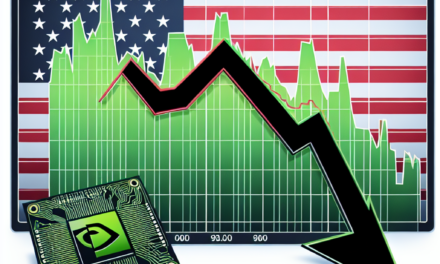“Stocks Plunge as Traders Reassess 2025 Rate Cut Hopes.”
Introduction
Stocks experienced a significant decline as traders reassessed the likelihood of interest rate cuts in 2025. Concerns over inflation persistence and economic growth have led to increased uncertainty in the markets, prompting investors to reevaluate their strategies. The shift in sentiment reflects a broader apprehension about the Federal Reserve’s monetary policy trajectory, as market participants grapple with the implications of potential rate adjustments on corporate earnings and overall economic stability. This volatility underscores the delicate balance between fostering growth and controlling inflation, leaving traders on edge as they navigate the evolving financial landscape.
Market Reactions to Rate Cut Speculations
In recent trading sessions, the stock market has experienced a significant downturn, primarily driven by traders’ growing skepticism regarding the prospects of a rate cut in 2025. This shift in sentiment has been influenced by a combination of economic indicators, Federal Reserve communications, and broader market dynamics. As investors digest the implications of these factors, the volatility in stock prices reflects a deeper uncertainty about the future trajectory of monetary policy and its impact on economic growth.
Initially, the market had been buoyed by expectations that the Federal Reserve would pivot towards a more accommodative stance, potentially lowering interest rates to stimulate economic activity. However, recent comments from Fed officials have suggested a more cautious approach, emphasizing the need to assess the ongoing economic recovery and inflationary pressures before making any decisions on rate adjustments. This has led traders to reassess their positions, resulting in a sell-off as confidence wanes in the likelihood of a near-term rate cut.
Moreover, economic data released in recent weeks has painted a mixed picture of the U.S. economy. While some indicators, such as employment figures and consumer spending, have shown resilience, others, including inflation rates and manufacturing output, have raised concerns about the sustainability of growth. As a result, traders are grappling with the potential for a prolonged period of elevated interest rates, which could dampen corporate earnings and consumer spending. This uncertainty has prompted a reevaluation of stock valuations, leading to a broader market correction.
In addition to domestic factors, global economic conditions have also played a role in shaping market reactions. Geopolitical tensions, supply chain disruptions, and fluctuating commodity prices have contributed to an environment of heightened risk. As investors weigh these external influences against the backdrop of U.S. monetary policy, the interconnectedness of global markets becomes increasingly apparent. Consequently, the apprehension surrounding rate cuts has not only affected U.S. stocks but has also reverberated through international markets, further amplifying the volatility.
As traders navigate this complex landscape, the implications for various sectors are becoming clearer. For instance, interest-sensitive sectors such as real estate and utilities have faced heightened pressure as the prospect of sustained high rates looms. Conversely, financial stocks, which typically benefit from rising interest rates, have seen a mixed response as the market grapples with the potential for a slower economic growth trajectory. This divergence underscores the importance of sector-specific analysis in an environment characterized by uncertainty.
Looking ahead, the market’s reaction to rate cut speculations will likely continue to evolve as new economic data emerges and the Federal Reserve communicates its policy intentions. Investors will be closely monitoring upcoming economic reports and Fed meetings for clues about the central bank’s future direction. In this context, the interplay between market sentiment and economic fundamentals will remain a critical factor influencing stock prices.
In conclusion, the recent plunge in stocks can be attributed to traders questioning the likelihood of a rate cut in 2025, driven by a combination of mixed economic signals and cautious Fed communications. As the market grapples with these uncertainties, the implications for various sectors and the overall economic outlook will be pivotal in shaping investment strategies moving forward. The evolving landscape underscores the necessity for investors to remain vigilant and adaptable in the face of changing market dynamics.
Analyzing the Impact of Interest Rates on Stock Performance
The relationship between interest rates and stock performance is a critical area of focus for investors, particularly in times of economic uncertainty. As traders grapple with the implications of potential interest rate cuts in 2025, recent market movements have underscored the sensitivity of stock prices to changes in monetary policy. When interest rates rise, borrowing costs increase, which can lead to reduced consumer spending and lower corporate profits. Consequently, higher rates often result in a decline in stock valuations, as investors adjust their expectations for future earnings.
Conversely, when interest rates are lowered, the cost of borrowing decreases, which can stimulate economic activity. This environment typically encourages both consumer spending and business investment, leading to improved corporate earnings and, in turn, higher stock prices. However, the anticipation of future rate cuts can also create volatility in the stock market, as traders speculate on the timing and magnitude of such changes. In the current climate, the uncertainty surrounding the Federal Reserve’s policy decisions has led to increased market fluctuations, as investors weigh the potential benefits of lower rates against the risks of inflation and economic instability.
Moreover, the impact of interest rates on stock performance is not uniform across all sectors. For instance, growth stocks, which often rely on future earnings for their valuations, tend to be more sensitive to interest rate changes than value stocks. When rates are high, the present value of future earnings diminishes, making growth stocks less attractive. Conversely, in a low-interest-rate environment, these stocks can thrive as investors seek higher returns in a low-yield landscape. This dynamic has been particularly evident in recent trading sessions, where technology and consumer discretionary stocks have experienced significant declines as traders reassess their growth prospects in light of potential rate hikes.
Additionally, the bond market plays a crucial role in shaping investor sentiment regarding interest rates and stock performance. As yields on government bonds rise, they can become more attractive relative to equities, prompting investors to shift their portfolios away from stocks and into fixed-income securities. This shift can exacerbate downward pressure on stock prices, particularly in a rising rate environment. Furthermore, the interplay between inflation expectations and interest rates adds another layer of complexity to the analysis. If inflation remains elevated, central banks may be compelled to maintain higher interest rates for an extended period, which could further dampen stock market performance.
In light of these factors, it is essential for investors to remain vigilant and informed about the broader economic landscape. Understanding the potential implications of interest rate changes on various sectors can provide valuable insights for making informed investment decisions. As traders continue to question the prospects of rate cuts in 2025, the stock market may experience heightened volatility, reflecting the ongoing uncertainty surrounding monetary policy. Ultimately, the interplay between interest rates and stock performance will remain a pivotal consideration for investors navigating the complexities of the financial markets. By closely monitoring economic indicators and central bank communications, traders can better position themselves to respond to the evolving landscape and mitigate potential risks associated with interest rate fluctuations.
Key Economic Indicators Influencing Trader Sentiment
In recent weeks, the stock market has experienced significant volatility, primarily driven by traders reassessing the prospects of interest rate cuts in 2025. This shift in sentiment can be attributed to a variety of key economic indicators that are influencing market dynamics and trader behavior. As investors closely monitor these indicators, their reactions can lead to substantial fluctuations in stock prices, reflecting broader concerns about the economic landscape.
One of the most critical indicators affecting trader sentiment is the inflation rate. Recent data has shown that inflation remains stubbornly high, prompting concerns that the Federal Reserve may maintain its current interest rate levels for an extended period. Traders are particularly sensitive to inflation figures, as persistent inflation can erode purchasing power and dampen economic growth. Consequently, when inflation reports exceed expectations, traders often react by selling off stocks, fearing that the Fed will be compelled to adopt a more hawkish stance.
In addition to inflation, employment figures play a pivotal role in shaping market sentiment. The latest employment reports have indicated a robust job market, with unemployment rates remaining low and job creation continuing at a steady pace. While a strong labor market is generally viewed as a positive sign for the economy, it can also lead to concerns about wage inflation. If wages rise too quickly, it could further fuel inflationary pressures, leading traders to speculate that the Fed may delay any potential rate cuts. This uncertainty surrounding employment data can create a ripple effect in the stock market, as traders adjust their positions based on their expectations of future monetary policy.
Moreover, consumer spending is another vital economic indicator that traders are closely watching. Recent reports have shown that consumer spending has remained resilient, despite rising prices. This resilience is crucial, as consumer spending accounts for a significant portion of economic activity. However, if spending begins to wane due to higher costs or reduced consumer confidence, it could signal a slowdown in economic growth. Such a scenario would likely prompt traders to reassess their outlook for rate cuts, leading to further declines in stock prices.
Furthermore, geopolitical events and global economic conditions also contribute to trader sentiment. For instance, ongoing tensions in various regions can create uncertainty in the markets, prompting traders to adopt a more cautious approach. Additionally, developments in major economies, such as China and the Eurozone, can have far-reaching implications for global trade and economic growth. As traders digest news from these regions, their reactions can significantly impact stock prices, particularly in sectors that are sensitive to international trade dynamics.
As the market continues to grapple with these key economic indicators, the outlook for interest rate cuts in 2025 remains uncertain. Traders are left to navigate a complex landscape where inflation, employment, consumer spending, and geopolitical factors intertwine. This intricate web of influences underscores the challenges faced by investors as they attempt to forecast future market movements. Ultimately, the interplay of these economic indicators will shape trader sentiment and influence stock market performance in the months to come. As such, staying informed about these developments is essential for anyone looking to understand the current market environment and make informed investment decisions.
Historical Trends: Rate Cuts and Stock Market Responses
The relationship between interest rate cuts and stock market performance has been a subject of extensive analysis and debate among economists and investors alike. Historically, rate cuts have often been perceived as a signal of economic distress, prompting traders to reassess their positions in the stock market. This dynamic was particularly evident during periods of economic downturn, where the Federal Reserve’s decision to lower rates aimed to stimulate growth by making borrowing cheaper. However, the immediate response of the stock market to such cuts has not always been straightforward.
In the past, when the Federal Reserve has implemented rate cuts, the stock market has typically reacted with a mix of optimism and caution. For instance, during the financial crisis of 2008, the Fed slashed rates aggressively in an attempt to stabilize the economy. Initially, this led to a rally in stock prices as investors anticipated a recovery. However, the underlying economic conditions remained fragile, and the market soon faced significant volatility as concerns about the sustainability of the recovery emerged. This pattern illustrates that while rate cuts can provide a short-term boost to investor sentiment, they do not guarantee long-term market stability.
Moreover, the timing of rate cuts plays a crucial role in shaping market responses. Historical data indicates that when rate cuts are implemented in a proactive manner—before economic indicators show significant deterioration—markets tend to respond more favorably. Conversely, when cuts are perceived as reactive measures to worsening economic conditions, the stock market often reacts negatively. This phenomenon can be attributed to the uncertainty surrounding the economic outlook, which can lead to increased volatility as traders grapple with conflicting signals.
Transitioning to more recent events, the anticipation of future rate cuts has also influenced market behavior. For example, in the lead-up to the Federal Reserve’s decisions, speculation about potential cuts can create a ripple effect in the stock market. Traders often adjust their portfolios based on expectations, leading to fluctuations in stock prices even before any official announcements are made. This preemptive behavior underscores the importance of market sentiment and the psychological factors that drive trading decisions.
As we look ahead to 2025, the current landscape is marked by uncertainty regarding the timing and magnitude of potential rate cuts. Recent market movements have reflected this uncertainty, with traders questioning whether the Fed will act decisively in response to economic indicators. The recent plunge in stock prices can be seen as a reaction to these doubts, as investors weigh the implications of a potentially prolonged period of high interest rates against the backdrop of an evolving economic environment.
In conclusion, the historical trends surrounding rate cuts and stock market responses reveal a complex interplay between monetary policy and investor sentiment. While rate cuts can provide a temporary boost to the stock market, their effectiveness is often contingent upon the broader economic context and the timing of the cuts. As traders navigate the uncertainties of the current economic landscape, the lessons of the past will undoubtedly inform their strategies and expectations. Ultimately, understanding these historical dynamics is essential for making informed investment decisions in an ever-changing market.
Sector Performance During Rate Cut Uncertainty
As traders grapple with the implications of potential interest rate cuts in 2025, the performance of various sectors within the stock market has come under scrutiny. The uncertainty surrounding monetary policy has led to a notable divergence in sector performance, reflecting the varying sensitivities of different industries to interest rate fluctuations. In this context, it is essential to analyze how these sectors are responding to the prevailing economic climate and the anticipated shifts in monetary policy.
Historically, sectors such as utilities and consumer staples tend to perform well during periods of low interest rates. This is primarily due to their stable cash flows and the essential nature of their products, which make them less sensitive to economic cycles. As interest rates decline, the cost of borrowing decreases, allowing these companies to invest in growth opportunities while also providing attractive dividends to investors. However, the current uncertainty regarding the timing and magnitude of potential rate cuts has led to a cautious approach among investors, resulting in mixed performance within these traditionally defensive sectors.
Conversely, sectors such as technology and consumer discretionary are often more volatile in response to interest rate changes. These industries typically rely on growth and expansion, which can be hampered by higher borrowing costs. As traders question the likelihood of rate cuts in 2025, technology stocks, which had previously enjoyed a robust rally, have begun to experience increased selling pressure. This shift reflects a broader concern that elevated interest rates could stifle innovation and investment in the tech sector, leading to a reevaluation of growth expectations.
Moreover, the financial sector presents a unique case during this period of uncertainty. Banks and financial institutions generally benefit from higher interest rates, as they can charge more for loans compared to what they pay on deposits. However, the prospect of rate cuts in the near future has led to a decline in bank stocks, as traders anticipate a narrowing of profit margins. This situation underscores the complexity of the current market environment, where the potential for rate cuts is creating a paradox for financial institutions that thrive in a higher-rate landscape.
In addition to these sectors, the energy market has also felt the impact of rate cut speculation. Energy stocks are often influenced by global economic conditions and demand for oil and gas. As traders weigh the potential for economic slowdown against the backdrop of interest rate changes, energy stocks have exhibited volatility. A rate cut could stimulate economic activity and increase demand for energy, yet the uncertainty surrounding the timing of such cuts has led to a cautious stance among investors.
As the market continues to react to the evolving narrative around interest rates, it is clear that sector performance will remain uneven. Investors are likely to adopt a more selective approach, focusing on sectors that can withstand economic fluctuations and benefit from a potential easing of monetary policy. In this environment, understanding the nuances of each sector’s relationship with interest rates will be crucial for making informed investment decisions. Ultimately, as traders navigate this complex landscape, the interplay between rate cut prospects and sector performance will be a key factor shaping market dynamics in the months to come.
Expert Opinions on Future Rate Cut Possibilities
As the financial markets react to shifting economic indicators, expert opinions on the prospects of a rate cut in 2025 have become increasingly significant. Recent fluctuations in stock prices have prompted traders to reassess their expectations regarding monetary policy, particularly in light of the Federal Reserve’s ongoing efforts to manage inflation and stimulate economic growth. Analysts are now scrutinizing various economic data points, including employment figures, consumer spending, and inflation rates, to gauge the likelihood of a rate cut in the near future.
Many economists argue that the current economic landscape presents a complex picture. On one hand, persistent inflationary pressures have led the Federal Reserve to adopt a cautious stance, maintaining higher interest rates to curb price increases. This approach has resulted in a tightening of financial conditions, which, in turn, has raised concerns among traders about the potential for an economic slowdown. As a result, some experts suggest that the Fed may be reluctant to implement rate cuts until there is clear evidence of sustained economic stability. They emphasize that any premature easing of monetary policy could exacerbate inflationary trends, undermining the progress made in recent years.
Conversely, other analysts contend that the economic environment may warrant a reassessment of rate cut timelines. They point to signs of slowing growth, particularly in sectors sensitive to interest rates, such as housing and consumer durables. These experts argue that if economic indicators continue to trend downward, the Federal Reserve may be compelled to consider rate cuts sooner than anticipated. They highlight that a proactive approach could help mitigate the risks of a recession, providing much-needed support to businesses and consumers alike.
Moreover, the global economic context cannot be overlooked. With geopolitical tensions and supply chain disruptions continuing to impact markets, experts are increasingly considering how these external factors may influence domestic monetary policy. Some analysts suggest that the Fed may need to adopt a more flexible approach, taking into account not only domestic economic conditions but also international developments that could affect the U.S. economy. This perspective underscores the interconnectedness of global markets and the importance of a comprehensive analysis when forecasting future rate cuts.
In addition to economic indicators, market sentiment plays a crucial role in shaping expectations around interest rates. Recent volatility in stock prices has led to heightened uncertainty among investors, prompting many to reassess their strategies. As traders grapple with the implications of potential rate cuts, they are closely monitoring the Fed’s communications for any signals regarding future policy shifts. This heightened scrutiny reflects a broader trend in which market participants are increasingly attuned to the nuances of central bank messaging, recognizing that even subtle changes in tone can have significant implications for market dynamics.
Ultimately, the question of whether the Federal Reserve will implement rate cuts in 2025 remains open to interpretation. While some experts advocate for a cautious approach, emphasizing the need for sustained economic stability before any policy shifts, others argue for a more aggressive stance in response to emerging economic challenges. As the landscape continues to evolve, traders and analysts alike will need to remain vigilant, adapting their strategies in response to new data and insights. In this context, the interplay between economic indicators, market sentiment, and global developments will be critical in shaping the future trajectory of interest rates and, consequently, the broader financial markets.
Strategies for Investors Amidst Market Volatility
As market volatility continues to dominate the financial landscape, investors are increasingly seeking strategies to navigate the uncertainty that has arisen from recent stock market fluctuations. The recent plunge in stock prices, driven by traders questioning the prospects of a rate cut in 2025, has underscored the importance of a well-thought-out investment approach. In this environment, it is crucial for investors to remain vigilant and adaptable, employing strategies that can help mitigate risks while capitalizing on potential opportunities.
One effective strategy is diversification, which involves spreading investments across various asset classes, sectors, and geographic regions. By diversifying their portfolios, investors can reduce the impact of a downturn in any single investment. For instance, while equities may be experiencing volatility, other asset classes such as bonds, real estate, or commodities may provide stability and even growth. This approach not only helps to cushion against losses but also positions investors to benefit from different market conditions.
In addition to diversification, maintaining a long-term perspective is essential during periods of market turbulence. Short-term fluctuations can often lead to emotional decision-making, which may result in hasty actions that could undermine an investor’s financial goals. By focusing on long-term objectives and adhering to a disciplined investment strategy, investors can ride out the volatility and potentially benefit from the market’s eventual recovery. This perspective encourages investors to view downturns as opportunities to acquire quality assets at discounted prices, rather than as reasons to panic.
Moreover, investors should consider employing dollar-cost averaging as a strategy to navigate market volatility. This technique involves consistently investing a fixed amount of money at regular intervals, regardless of market conditions. By doing so, investors can take advantage of lower prices during downturns while avoiding the pitfalls of trying to time the market. Over time, this approach can lead to a lower average cost per share and potentially enhance overall returns.
Another important consideration is the need for liquidity. In uncertain markets, having access to cash or liquid assets can provide investors with the flexibility to respond to opportunities as they arise. This liquidity can be particularly valuable during periods of market distress, allowing investors to capitalize on attractive valuations or to weather financial emergencies without having to sell investments at unfavorable prices. Therefore, maintaining an appropriate level of cash reserves is a prudent strategy that can help investors navigate the complexities of a volatile market.
Furthermore, staying informed about economic indicators and market trends is vital for making informed investment decisions. Understanding the broader economic context, including interest rate expectations and inflationary pressures, can help investors anticipate potential market movements. By keeping abreast of relevant news and analysis, investors can better position themselves to adjust their strategies in response to changing conditions.
In conclusion, while the current market volatility presents challenges, it also offers opportunities for those who are prepared. By employing strategies such as diversification, maintaining a long-term perspective, utilizing dollar-cost averaging, ensuring liquidity, and staying informed, investors can navigate the uncertainties of the market more effectively. Ultimately, a disciplined and informed approach can help investors not only weather the storm but also emerge stronger in the face of adversity.
Q&A
1. **Question:** What caused the recent plunge in stock prices?
**Answer:** The plunge was primarily driven by traders reassessing the likelihood of interest rate cuts in 2025, leading to increased uncertainty in the market.
2. **Question:** How did traders react to economic data releases?
**Answer:** Traders reacted by selling off stocks, as stronger-than-expected economic data suggested that the Federal Reserve might maintain higher interest rates for a longer period.
3. **Question:** What sectors were most affected by the stock market decline?
**Answer:** Technology and consumer discretionary sectors were among the most affected, as they are typically more sensitive to interest rate changes.
4. **Question:** What are the implications of a delayed rate cut for investors?
**Answer:** A delayed rate cut could lead to higher borrowing costs and reduced consumer spending, negatively impacting corporate earnings and stock valuations.
5. **Question:** How did the bond market respond to the stock market’s decline?
**Answer:** The bond market saw an increase in yields as investors adjusted their expectations for future interest rates, reflecting concerns over prolonged high rates.
6. **Question:** What role did inflation concerns play in the stock market’s performance?
**Answer:** Persistent inflation concerns contributed to the market’s volatility, as traders feared that the Federal Reserve would prioritize combating inflation over cutting rates.
7. **Question:** What should investors consider in light of the current market conditions?
**Answer:** Investors should consider diversifying their portfolios, staying informed about economic indicators, and reassessing their risk tolerance in a potentially volatile environment.
Conclusion
Stocks have experienced a significant decline as traders express skepticism regarding the likelihood of interest rate cuts in 2025. This uncertainty stems from mixed economic indicators and the Federal Reserve’s commitment to controlling inflation, leading to a reassessment of future monetary policy. As a result, investor sentiment has turned cautious, prompting a sell-off in equities and highlighting the ongoing volatility in the market.





